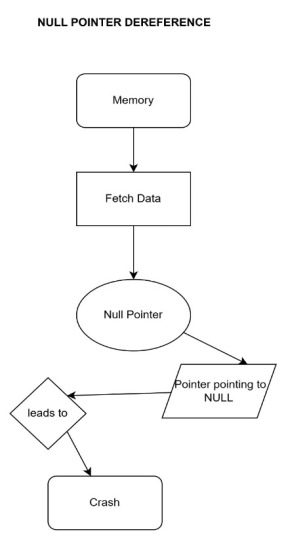Null Pointer Dereference
Introduction
Null pointer dereference is a critical programming flaw that occurs when a program attempts to access or manipulate memory via a pointer that has not been properly initialized or is explicitly set to NULL. This issue can result in undefined behavior, application crashes, security vulnerabilities, and system instability. Addressing null pointer dereference is essential for building robust, secure, and reliable software.
Causes of Null Pointer Dereference
- Uninitialized Pointers: Declaring pointers without assigning them a valid memory address.
- Explicit Null Assignment: Setting a pointer to
NULLand mistakenly dereferencing it. - Logic Flaws in Code: Errors in the program's control flow leading to unintended pointer usage.
- Improper Error Handling: Failing to handle memory allocation errors or incorrect function return values.
Implications of Null Pointer Dereference
- Program Crashes: Dereferencing a
NULLpointer often triggers segmentation faults, causing applications to crash unexpectedly. - Security Vulnerabilities: Attackers can exploit null pointer dereference flaws to execute malicious code, potentially compromising system security.
- System Instability: Critical applications and operating systems can experience failures, impacting mission-critical functions.
- Data Integrity Issues: Dereferencing a
NULLpointer may lead to corrupted data and unpredictable program behavior.
Block Diagram of Null Pointer Dereference Architecture

Steps to Prevent Null Pointer Dereference
- Pointer Initialization: Always assign valid memory addresses to pointers or set them to
NULLwhen not in use. - Pointer Validation: Before dereferencing, check if the pointer is
NULLto avoid invalid memory access. - Error Handling in Memory Allocation: Ensure that memory allocation functions return valid pointers before proceeding.
- Static Analysis Tools: Leverage static analysis tools (e.g., Coverity, Clang Static Analyzer) to detect potential issues early in the development process.
- Safe Programming Practices: Use programming languages or frameworks that handle pointers automatically, reducing the risk of errors.
Debugging and Mitigation
- Use Debugging Tools: Utilize tools like gdb to trace program execution and pinpoint the exact location of null pointer dereferences.
- Include Logging: Log pointer assignments and dereferencing events to identify potential issues in real-time.
- Implement Unit Testing: Write comprehensive unit tests that specifically target pointer operations, ensuring that all edge cases are covered.
Conclusion
Null pointer dereference is a serious software vulnerability that can severely affect the stability, security, and integrity of a system. Developers must be proactive in understanding its causes and implementing preventive measures, such as proper pointer initialization, robust error handling, and the use of automated analysis tools. By following best practices, developers can significantly reduce the risks associated with null pointer dereferencing and ensure high-quality, reliable software.